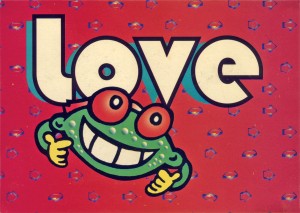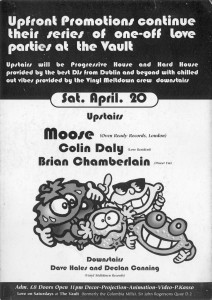
In the early 90s, a generation got caught up in the lawlessness of rave culture. Fed-up with boring slow sets and indie beats and yearning for some release from the constant talk of unemployment and emigration, young and old turned to a new kind of escapism: a bop at Columbia Mills.
The Mills, based down in Sir John Rogerson’s Quay, became a second home to early house DJs the Beat Club, the Influx Boys (Paul Davis and Johnny Moy), Darren Emerson, David Holmes, DJ Francois and Mark Kavanagh.
Its rooms were dark and small; it got so hot the sweat was literally running off the walls. It had two floors, one with traditional dance and techno and the basement with more laid-back tunes.
“The area wasn’t built up then, there was nothing down there, so when you were walking down to Columbia Mills you were almost walking into a wilderness,” said Cara Davidson, one of the regulars. “It was the same group of people who kept organising the clubs and they would just change the names and move from venue to venue,” she said.
“Everybody was on the same buzz and the people were pretty rough, but none of that mattered. People were just there for the music,” said Sharon Murray, another Mills regular. “All the guys would have their tops off and all the girls would be dancing around in next to nothing. You’d go in with a little bag on your back and dance in your bra, hot pants or little skirt,” said Sharon.
 Columbia Mills was just one part of a growing dance sub-culture that was taking Dublin by storm. “There hasn’t been anything as good as Columbia Mills since,” said Gary ‘Gedge’ Slevin, a DJ who played at Columbia Mills. “I think what stood out about Columbia Mills is that it was a mixed crowd, you’d have people that were into different music scenes coming together, dance music broke down all those boundaries in society,” he said.
Columbia Mills was just one part of a growing dance sub-culture that was taking Dublin by storm. “There hasn’t been anything as good as Columbia Mills since,” said Gary ‘Gedge’ Slevin, a DJ who played at Columbia Mills. “I think what stood out about Columbia Mills is that it was a mixed crowd, you’d have people that were into different music scenes coming together, dance music broke down all those boundaries in society,” he said.
The dance floor had fluorescent lights and pumping beats and while the jacks were constantly blocked, love was seeping out of every pore.
“Everybody was on a love buzz, you’d go to the toilet and meet someone in the queue and start talking to them and they’d be your best friend,” said Sharon. “That was the great thing. There was no rich, poor, gay, straight, there were no social divides. You’d just meet people and go to parties, there were no fights,” she said.
The brainchild of DJ Francois and Mick Heaney, the Mills offered a fresh take on nightlife in Dublin. Shaft, for instance, was a gay night (considering it was the mid-90s was a rather new and unknown phenomenon).
UFO was the Mill’s biggest night which crammed four to five hundred people into the former textile factory on a Friday night. (It was also the pub shown in the climax of The Commitments). The large crowds and the variety of drugs available eventually attracted the attention of the Guards, who carried out one of the biggest raids ever seen on Irish soil in 1994 – entering through the exits and entrances to the club and insisting everyone get down on their knees. “A good few people were arrested, making the headlines the next day. The authorities thought they were making headway into destroying the dance scene that was sweeping the country at the time,” said Slevin.
The raid helped bring about the club’s eventual demise – it was renamed Alien in 1995 and ran until the early noughties before closing shop. But the Mills managed to freeze a moment in time when nothing else mattered – only how hard you could dance.
Images are scans of original flyers from Columbia Mills.
By Liam Cahill

